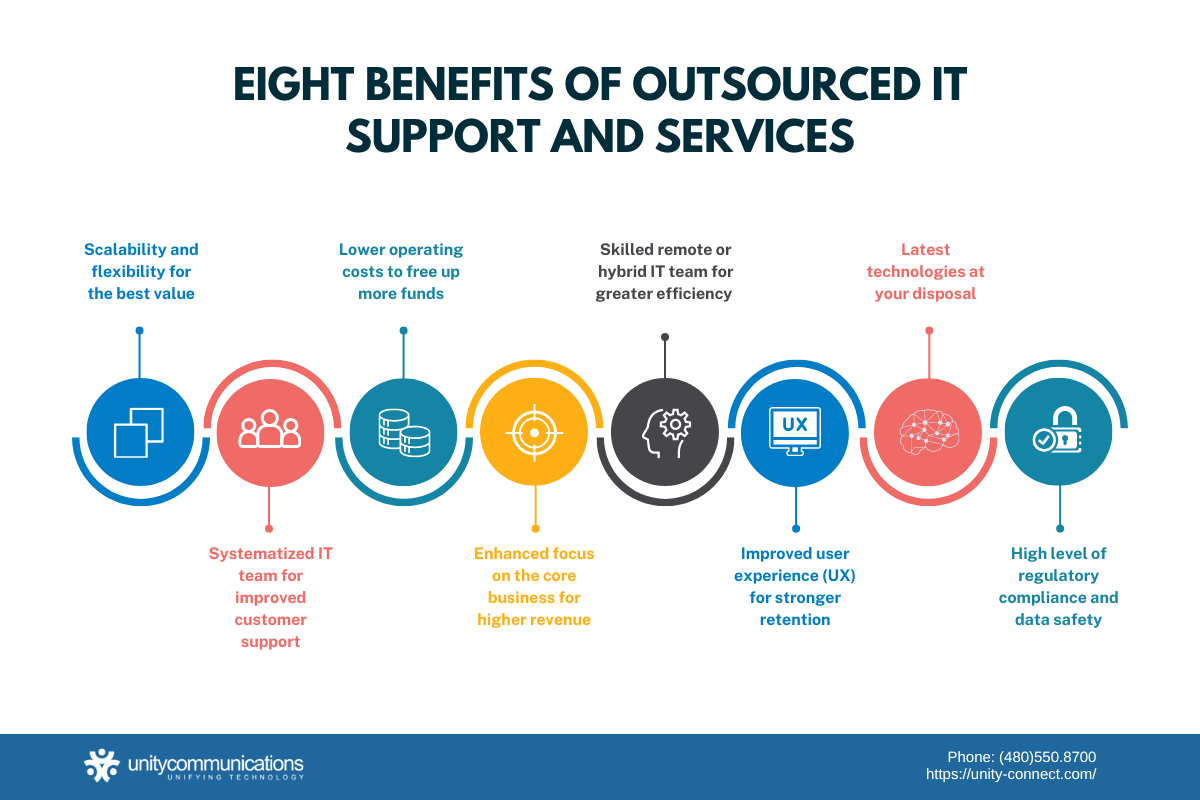Table of Contents
Benefits and costs are primary considerations for any business decision. You want to know whether your investment is worthwhile, especially when planning to outsource information technology (IT) processes.
This article outlines the benefits and costs of IT support outsourcing to help you make informed decisions for your organization.
Let’s go into detail!
Eight Benefits of Outsourced IT Support and Services

Generally speaking, companies wanting rapid growth outsource IT support and services. The reasons for choosing to outsource are quite varied.
Discover the many benefits of outsourcing below.
1. Scalability and Flexibility for the Best Value
Outsourcing technical support services enables you to scale up or down according to your business performance. Thus, you can more effectively manage operating costs.
A business process outsourcing (BPO) company provides you with the right number of IT agents and specialists to manage your tasks. It reduces the staff size when business is slow and increases staffing during periods of high contact volume. The cost to you increases or decreases as the size of your team changes to meet demand.
Hiring a third-party team is lighter on your budget than managing an in-house team. In the latter case, operating expenses stay fixed regardless of call volumes or sales transactions. You keep paying salaries even during times of slow demand.
2. Systematized IT Team for Improved Customer Support
An outsourced IT provider provides you with a team that enhances output and service quality. Outsourced technical support is structured into five tiers to address multiple issues and concerns.
- Tier 0 (T0) support lets customers address IT issues themselves without the help of an agent. It includes product or service information, blog posts, frequently asked questions (FAQs), video tutorials, community forums, and search functions. Your company’s website houses T0 support.
- Tier 1 (T1) support is often handled by an entry-level staff person or a bot. Steps for resolving problems include: collecting consumer information, analyzing issue details, and offering possible solutions. T1 solves about 75% of all technical concerns using basic IT knowledge and a management kit. T1 staffers help customers with common problems such as reinstalling operating systems and restoring passwords.
- Tier 2 (T2) support is resolved by a higher-level staff team. About 25% of technical problems T1 cannot solve reach this level. It is more expensive than T1 because the staff possesses higher technical capabilities and more extensive knowledge.
- Tier 3 (T3) support is for problems that require the best and most expensive IT specialists. They resolve the toughest technical issues that even T2 staff cannot fix. They develop creative and new solutions to highly challenging cases.
- Tier 4 (T4) support is an external service for issues and incidents not supported by an outsourced IT team. Typically, this entails contracted support for parts and components offered by your service providers.
3. Lower Operating Costs To Free up More Funds
Outsourced IT support and services lead to decreased daily expenses. Save on the following ongoing costs when you delegate processes to outside experts:
- Salary and remuneration. Full-time employees get fixed salaries and non-monetary compensation whether a business is struggling or thriving. You must also provide continuous benefits such as medical insurance.
- Staffing. Hiring IT staff entails spending on job ads, recruiters, applicant screening, interviewing, and onboarding. Your BPO partner shoulders these time-consuming and costly activities, readily providing you with a full-fledged team with little involvement or direct cost to your company.
- Training and upskilling. Technical support teams must stay ahead of the latest techniques and developments. Your BPO partner ensures contractors are up-to-date and upskilled for deployment. They provide constant training for your team without burdening you with the extra cost.
4. Enhanced Focus on the Core Business for Higher Revenue
Back-office outsourcing services let you concentrate on enhancing revenue-generating activities such as sales and marketing. An outsourced technical support team takes on tedious tasks on your behalf.
Outsourcing gives you a competitive advantage because it lets you focus on increasing your income in these ways:
- Broaden market reach quickly
- Allocate more funds to employee upskilling and next-generation technologies.
- Improve current product and service quality
- Develop and release the latest products and services
- Provide higher-quality service for a better customer experience
- Incentivize staff with better perks and incentives
5. Skilled Remote or Hybrid IT Team for Greater Efficiency
Businesses often outsource data entry services, help desks, customer service, and sales support. Outsourced IT teams access user data and devices remotely. They either work from home (WFH) or have a flexible work schedule. To keep your data safe, they use secure online portals.
A WFH team no longer needs to be on-site to fix technical problems. They can quickly respond to help requests and resolve them remotely due to advances in technological ability..
Outsourced IT support and services with remote workers are efficient because they offer the following:
- High-grade information security. A technical support team uses virtual private networks (VPNs), antivirus, and anti-malware programs to protect crucial consumer data from threats. They also leverage multiple passwords and identification procedures.
- Tight remote work guidelines. Your BPO partner provides stringent but fair policies for technical support teams to follow, thus promoting proper conduct. These rules are vital for better collaboration and workflow.
- Fully geared WFH staff. A service provider equips remote workers with the right software, hardware, and equipment to properly and accurately carry out their duties.
- Frequent online sessions. IT managers regularly hold video or audio meetings to track members’ daily performance, overall wellness, and morale.
- Experienced users of communication tools. A third-party help desk team depends on accessible communication software for uninterrupted and real-time interaction. Thus, remote workers must be familiar with Zoom, Skype, Microsoft Teams, Asana, and Slack.
6. Improved User Experience (UX) for Stronger Retention
UX captures an individual’s interaction with your product or service. It measures how convenient, satisfying, or difficult it is to use the following devices:
- Smartphone
- Laptop or desktop
- Website
- Tablet and similar digital device
- Web application or program
Here are some reasons to outsource tech solutions for better UX:
- Greater return on investment (ROI). Infusing funds into your UX activities increases ROI in the long run. Better UX means users will buy more. They are more likely to promote your products or services through social media or word-of-mouth.
- More positive reviews. Delivering favorable experiences to consumers builds and maintains their loyalty. They are thus unlikely to shift to another brand. Stronger loyalty translates to higher customer retention and lower marketing costs.
- Decreased operating costs. Better UX is cost-effective because you reduce advertising expenses to attract customers. It also implies that users encounter fewer technical defects, thus diminishing repair and maintenance costs.
- Heightened consumer awareness. UX allows IT outsourcing teams to examine user data for better evaluation of behaviors, likes, and dislikes. With this data, teams develop insight into consumption, purchase, and usage viewpoints in order to enhance products or services.
7. Latest Technologies at Your Disposal
You can use modern technologies with outsourced IT solutions to expedite and simplify processes.
BPO providers use cloud technology to take customer experience to the next level. Cloud-based platforms integrate multiple applications, including customer relationship management (CRM) software, for seamless workflow.
The latest technical support programs supplement BPO teams and track their performance. They let agents use self-service options, help avoid mistakes, and handle high call volumes.
Third-party vendors also invest in emerging technologies to provide sophisticated ways to oversee processes. The following are examples of next-generation technology:
- Robotic process automation (RPA) provides software robots that carry out repetitive activities. They shoulder burdensome tasks and allow human agents to attend to more urgent assignments.
- The Internet of things (IoT) is the interlocking of different digital devices that use the Internet to instantly exchange information.
- Artificial intelligence (AI) mimics human intelligence in computer systems and machines. Similar to RPA, AI is affordable and aids team output and efficiency.
- Cybersecurity protects data against online threats, cyber intrusions, and data breaches.
8. High Level of Regulatory Compliance and Data Safety
BPO providers strictly comply with data security guidelines. They ensure their clients abide by federal regulations and industry policies to avoid lawsuits and fines. They also stay updated on outsourced IT trends.
Here are the laws and standards that service providers follow:
- The Health Insurance Portability and Accountability Act of 1996 (HIPAA) is a federal law regulating the healthcare industry. It safeguards patient information from unauthorized disclosure.
- The Payment Card Industry Data Security Standard (PCI DSS) is a security standard obligating all companies to securely oversee credit card transactions. Its purpose is to reduce credit card theft, fraud, and scams with better handling of cardholder information.
- The General Data Protection Regulation (GDPR) is a regulation for businesses with clients in the European Union. Deemed the world’s most stringent privacy law, GDPR requires companies to safeguard consumer data and maintain its security at the highest level possible.
- The International Organization for Standardization (ISO) is an international group that accredits organizations that surpass its quality assurance requirements. Its strict policies cover all industries and businesses of all sizes.
- The Telemarketing and Consumer Fraud and Abuse Prevention Act protects consumers from telemarketing malpractices and abuses. Among other rules, it requires telemarketers to obtain a registration certificate before operation.
Four Pricing Structures of Outsourced IT Support and Services

BPO firms apply four pricing models: per-device fixed rate, per-user flat rate, monitoring only, and ad hoc fees. The pricing model determines the cost of your outsourced IT support and services.
Let’s take a closer look at each one.
- Per-device fixed fee. A flat-rate charge according to the number of devices you use. The price changes as you add or remove devices during a specific period. With this method, you can easily track costs. For example, if you plan to give each employee a laptop, just multiply the rate by the total number of laptops needed.
- Per-user flat rate. The service fee is fixed, but the number of users determines the total costs. This method aids your business expansion plans and is ideal if you have a limited budget and need to keep within careful parameters. For example, if you know you need 50 more agents next year. Multiply the cost per head by 50.
- Monitoring only. The BPO provider offers network reporting and notification services (e.g., disk optimization and virus-free computers). This is ideal for small businesses with limited budgets and strong cybersecurity requirements. It protects against cyber intruders, hackers, and threat actors.
- Ad hoc fees. IT support, and services are paid on demand. Costs are neither fixed nor ongoing. This is the right plan for companies that do not rely on IT and only require occasional technical assistance. Vendors charge more for special services, so you spend more on major technical issues.
Cost Types of Outsourced IT Support and Services
Outsourced IT support has both recurring and one-time costs. The following section differentiates the two cost types.
1. Recurring Costs
Recurring costs are running expenses for technical support. For example, your business makes monthly or quarterly payments for data security maintenance and system upgrades.
Each company has its own IT needs that the BPO provider agrees to address. Below is a service provider’s common pricing computation for outsourced technical processes:
- Service rates are calculated per total number of devices (e.g., smartphones, laptops, desktops, tablets, laptops), servers, and data quantity.
- The number of support hours required for each device and server is determined. The more devices and servers, the more support hours are required. The industry benchmark is around 25 support hours per device and server per annum, with a service rate of $100 per hour.
- From details 1 and 2, you can figure out the cost of IT outsourcing support with the following formula:
| (Number of devices + number of servers) x 25 support hours per year x $100 rate per hour = service fee |
Suppose you need IT services for 50 devices and servers. Multiply 50 by 25 hours. The result is 1,250, multiplied by $100 for the service rate per hour. The overall amount to be paid is $125,000 per year or about $10,417 per month ($125,000 divided by 12 months).
| (50 x 25) x $100 = $125,000 |
- In data quantity, the average industry rate is around $2,500 yearly, and the maximum storage capacity is 10,000 GB. That is about $208 per month ($2,500 divided by 12 months).
- From details 3 and 4, you should set aside a monthly budget of nearly $11,000 to cover your IT costs: $10,417 for the devices and servers, plus $208 for data volume storage.
2. One-time Costs
The following technical support outsourcing services are paid only once:
- Network implementation. This includes establishing connectivity, building email accounts, and deploying an IT system across the organization for your digital transformation efforts.
- Office applications (bulk purchase). The payment is substantial because you buy products in large quantities and install them in every department. Properly installing and configuring the applications are part of this expense.
Other Cost Aspects
Adding to your total technical support costs are the following:
- Upgrades. Replacing hardware, software, and networks with better or updated versions raises your IT costs. Regular upgrades are important to improve your platform and provide higher security.
- Maintenance. Expenses for managing and upkeeping your IT systems and processes are unavoidable. An outdated hardware or platform with rare parts leads to higher costs. Technical maintenance includes:
- Testing data
- Fixing or removing design errors
- Repairing connectivity and hardware
- Updating documentation and user support
- Deleting programs
Costs of Outsourced IT Support and Services

A service provider’s location is a major factor in how much it costs to outsource IT support and services. This article focuses on offshore and onshore outsourced technical support.
Offshore Outsourcing
Offshore outsourcing delegates IT tasks to a BPO company in a distant country with low labor costs, good tax incentives, and a trainable workforce. These countries have a lower cost of living, making their services more affordable.
Offshoring can significantly reduce the cost of outsourced IT services. The Asia-Pacific region has an ample supply of technically skilled, English-speaking employees. Their main competitive advantage is their cost-effective and reliable workforce.
To give you a better idea of the cost difference, here is a comparison of the salaries of technical support specialists in the U.S. and Asian countries (e.g., India and the Philippines).
Technical Support Roles (Salary Converted to Monthly in U.S. Dollars)
Source: Glassdoor
| Location | Supervisor/Manager | Specialist | Representative |
|---|---|---|---|
| Asian Countries | 2,000 – 4,800 | 640 – 1,470 | 429 – 1,409 |
| U.S. | 5,350 | 4,400 | 3,700 |
Onshore Outsourcing
Onshore outsourcing, also known as domestic or local outsourcing, assigns processes to a service provider in the same country as your headquarters. The advantages of this type of outsourcing are:
- Higher priority on core competencies
- Decreased operating expenses
- Sustained high-quality control
- Improved customer experience quality
- Faster response to business requirements
- Zero or minimal time-zone differences
Onshoring makes talking to customers easier because of fewer cultural differences and language barriers. This practice matches customers with agents of a similar background, language, and demographic. It ensures a consistently high customer support experience.
But bear in mind the following disadvantages of onshore outsourcing:
- Contractors’ salaries are similar to or higher than your in-house tech support team since the same local labor laws cover both organizations.
- The total cost includes the salaries of third-party technical support agents.
High labor rates are the main issue with onshore IT outsourcing. Average salary rates per hour in the U.S. range from $21 to $31 (40 hours per week), while rates in Asia can be half of that.
Cost reduction via onshoring is still possible. The business advantage of the onshore BPO provider is its large business network, more advanced infrastructure and technology, and extensive expertise. These elements can help reduce operating expenses in the long term.
Cost Savings With Offshore Outsourcing
Offshoring is almost always more affordable than onshoring. Here is a basic comparison to give you an overall picture of outsourced IT support and service pricing.
Offshore
You need the following technical positions for back-office outsourcing:
- Eight technical support representatives (TSR)
- Three technical specialists (TS)
- One IT manager (ITM)
If you outsource overseas, the costs will be (using the highest salary from the table above):
- Eight TSR x monthly salary = 8 x $1,409 = $11,272
- Three TS x monthly salary = 3 x $1,470 = $4,410
- One ITM x monthly salary = 1 x $4,800 = $4,800
Your estimated total costs will be $11,272 + 4,410 + 4,800 = $20,482 per month.
Onshore
When hiring the same number of staff, onshoring costs will be:
- Eight TSR x monthly salary = 8 x $3,700 = $29,600
- Three TS x monthly salary = 3 x $4,400 = $13,200
- One ITM x monthly salary = 1 x $5,350 = $5,350
Your estimated total costs will be $29,600 + 13,200 + 5,350 = $48,150 per month.
Cost Savings
The savings you will make is $48,150 less $20,482 = $27,668
This is a simple comparison and not the exact way to compute the actual costs. You should contact a BPO company for further details so you can make a more exact comparison.
The Bottom Line
At this point, you should have gained more knowledge of the benefits and costs of outsourced IT support and services. The actual cost of IT outsourcing is based on your technical support needs. You recruit the third-party technical support team and decide how many agents are needed.
While this article provides useful information, choosing the best pricing plan to maximize outsourcing is up to you. Do your due diligence and learn about the costs associated with using the services of a BPO company. Lastly, determine whether to outsource locally or overseas.




